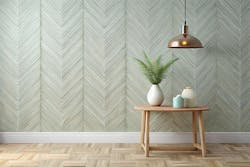The Power of Wallcoverings in Creating Salutogenic Spaces
In the places we live, work, heal, and learn, design choices have a profound impact on how we feel. A growing design philosophy called salutogenesis helps us understand why. Instead of asking what causes illness, it asks: What supports health?
Coined by sociologist Aaron Antonovsky, salutogenesis focuses on the conditions that foster well-being. Central to the concept is something called the Sense of Coherence (SOC)—a person’s belief that life is:
- Comprehensible (I understand what’s happening)
- Manageable (I have the tools to deal with it)
- Meaningful (This has purpose)
When these elements are supported by one’s environment, people tend to feel healthier, more resilient, and more empowered.
And here’s where wallcoverings come in. Often overlooked as purely decorative, wallcoverings are emerging as powerful tools in creating salutogenic spaces—especially now, as the industry evolves with new technology and sustainable materials.
Why Wallcoverings Matter
Wallcoverings influence more than aesthetics. They affect acoustics, lighting, cleanliness, and even how safe or grounded a space feels. When selected with intention, wallcoverings can directly support the three pillars of salutogenesis.
Comprehensibility. Wallcoverings can help make spaces easier to understand and navigate. Through color zoning, visual patterns, or integrated signage, wallcoverings can guide people through unfamiliar environments such as hospitals, schools, and large offices. Design consistency across walls, flooring, and furniture creates visual clarity, reducing cognitive load and stress.
Manageability. Wallcoverings can contribute to a sense of control and comfort through sensory support. Acoustic wallcoverings help soften noisy environments like classrooms or open-plan offices, while anti-microbial finishes promote hygiene in healthcare and hospitality settings. Low-glare textures can even reduce visual strain, particularly in spaces where focus is essential.
Thanks to innovations in materials, modern wallcoverings can now be stain-resistant, self-sanitizing, and even moisture-regulating—making spaces not just manageable, but easier to maintain.
Meaningfulness. A meaningful space is one that reflects our values, culture, or personal identity. Wallcoverings can achieve this in a number of ways. They can feature local artwork, nature motifs, or community stories. Particularly trending are biophilic designs that mimic the textures and patterns of the natural world to foster that connection between humans and nature. Encouraging personalization can be especially grounding in education and healthcare environments, creating a sense of belonging and support. When the walls “speak to us,” spaces feel more personal, more human, and more healing.
The Innovation Behind the Wellness
The wallcovering industry is evolving rapidly—driven by the science of well-being and a push toward sustainability. Advanced materials and fabrication techniques continue to emerge and grow in adoption.
Eco-Conscious Materials. Manufacturers are using recycled fibers, natural substrates (like cork and bamboo), and low-VOC (volatile organic compounds) inks to improve indoor air quality. Many products are now GREENGUARD or Cradle-to-Cradle certified, signaling reduced environmental and health impacts.
Smart and Responsive Surfaces. New wallcoverings are engineered to resist bacteria, absorb sound, or even change appearance in response to light. In high-traffic or high-risk areas, these advancements can support better health and safety without sacrificing design.
Digital Customization. Thanks to advanced printing, designers can now custom create wallcoverings that reflect the purpose and identity of a space—whether it’s student artwork in a school, calming nature scenes in a hospital, or branded storytelling in a corporate lobby.
These innovations align perfectly with the salutogenic goal: to create spaces that actively improve how people feel and function.
Final Thoughts
Design isn’t just about how a space looks—it’s about how it makes people feel. Salutogenesis reminds us that spaces should help people thrive, not just survive.
Wallcoverings can calm, clarify, inspire, and connect. As materials continue to evolve, and public awareness of well-being grows, wallcoverings have a critical role to play in shaping spaces that are not just functional, but truly life-enhancing.
About the Author
Heidi Lapka
Heidi Lapka serves as the executive director of the Wallcoverings Association, a non-profit trade association that provides a vehicle for communications between various segments of the wallcoverings industry and design professions.

